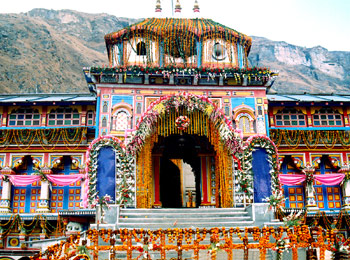- Vishnu
Badrinath Temple
- Rishikesh,Uttarakhand
- View on map
- Tell us about this temple
Overview
Guarded on either side by the two mountains of Nar and Narayan, the Neelkanth Peak provides a splendid backdrop to Badrinath, one of the ‘Four Dhams’. One of the most celebrated pilgrim spots in the country, it plays host to the famous Badrinath Temple. Legend has it that Lord Vishnu came to the area, called ‘Badri Van’, or the berry garden, to meditate after Narad rebuked the Lord for being immersed in worldly pleasures.
About The Temple
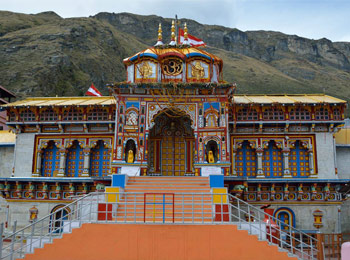
Facing the temple at the bank of Alaknanda River is a hot water spring known as "Tapt Kund", a bath in which is very refreshing to all travellers. Dedicated to Lord Vishnu, the temple of Shri Badrinathji, is 5 m high, built in the form of a cone with a small cupola of a gilt bull and spire. The temple opens every year in the month of April-May and closes for winters in the third week of November. Even though legend dates the temple back to the Vedic age, Guru Adi Shankaracharya has established the present temple. The temple has three parts - Garbha Grih (The Sanctum Sanctorum), Darshan Mandap (for pujas) and Sabha Mandap (for devotees to assemble). Sandwiched between Nar and Narayan mountain ranges, Badrinath in the Chamoli district of Uttarakhand is naturally bestowed with pristine surroundings. One among the most sought after pilgrim centres in the Indian subcontinent, Badrinath is beautifully set in the backdrop of the colossal Neelkanth mountain peak. The term Badrinath is a derivative of badri, which means the place where beries grow abundantly. A place, which holds so many myths and legends, Badrinath acquires predominance in the travel itinerary of a pilgrim. The popular belief is that Badarinath was the domain of Lord Shiva, and Lord Vishnu managed to unseat Shiva from here to Kedarnath. Another belief is that when Ganga made her descend to earth she split up in to twelve streams and one among the channels, Alakananda felt on Kedarnath. Sanctity and holiness of Badrinath festooned it with accolades since from the Vedic ages. This sacred abode of Nara-Narayana sages had been a revered seat and the Vedas like Srimad Bhagavatam, gave testimony to its devoutness. It is not just shrines and pilgrimage that Badrinath offers. It proffers the awesome beauty of the snow clad mountain peaks and the surging landscapes of the Garhwal region. It is a scenic place with picture book sceneries, undulating peaks, sacred ponds and water bodies, Badrinath makes the visitor spellbound with its unparalleled gorgeousness. This majestic look of Badrinath is attributed much by the presence of the magnificent rivers Rishi Ganga and Alaknanda. Apart from the natural beauty, Badrinath presents excellent opportunity for those who love escapades and recreational activities.
About The Deity
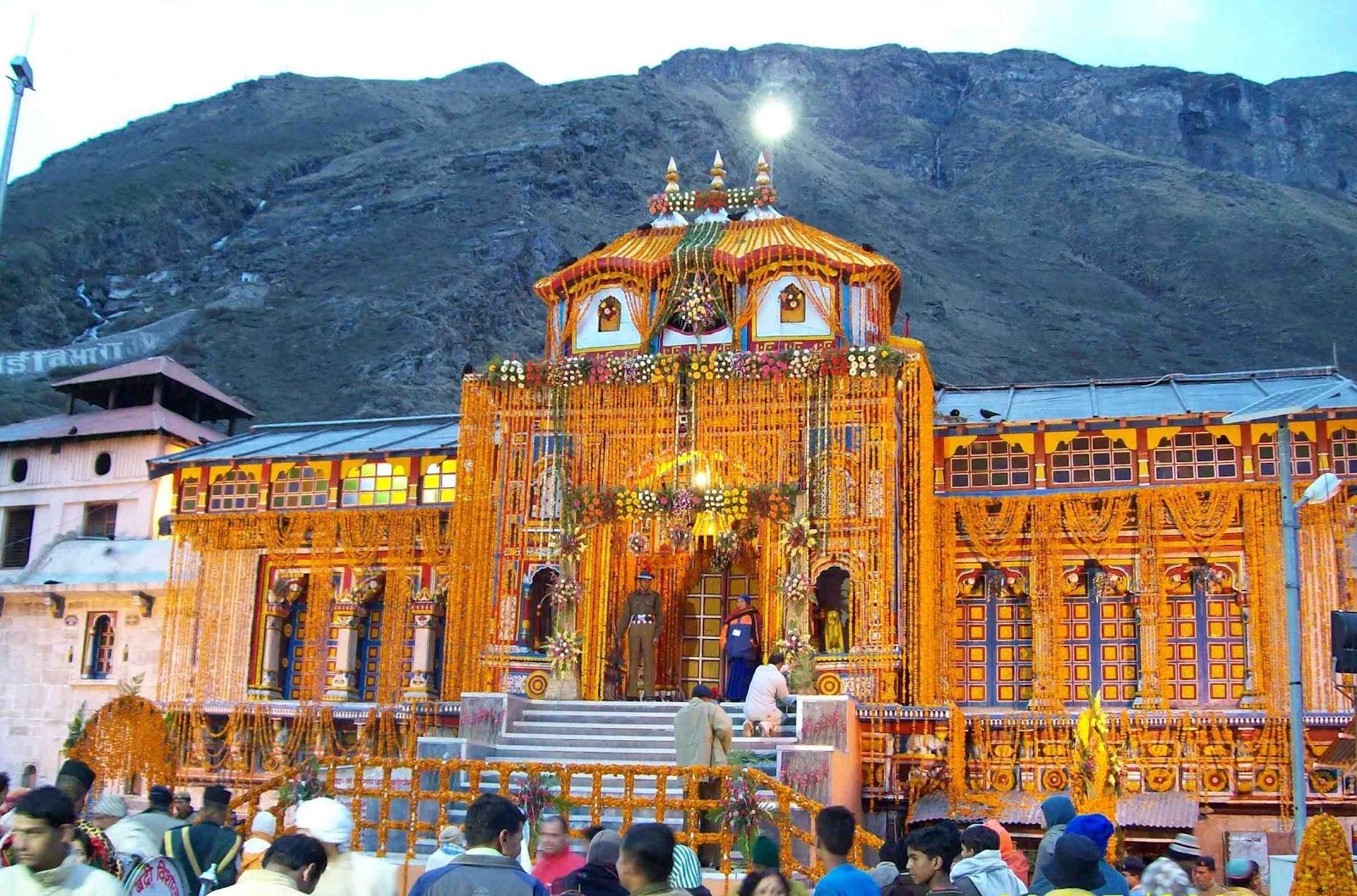
The main deity is a meditating Lord Vishnu.The image of the presiding deity worshipped in the temple is a 1 m (3.3 ft) tall, black stone statue of Vishnu in the form of Badrinarayan. The statue is considered by many Hindus to be one of eight swayam vyakta kshetras, or self-manifested statues of Vishnu
Legend and stories
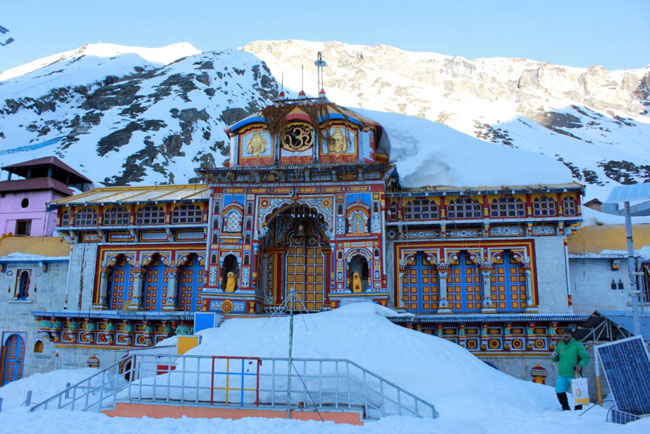
According to the Bhagavata Purana, "There in Badrikashram the supreme being (Vishnu), in his incarnation as the sages Nara and Narayana, had been undergoing great penance since time immemorial for the welfare of all living entities." (Bhagavata Purana 3.4.22) The Badrinath area is referred to as Badari or Badarikaashram in Hindu scriptures. It is a place sacred to Vishnu, particularly in Vishnu's dual form of Nara-Narayana. Thus, in the Mahabharata, Krishna, addressing Arjuna, says, "Thou wast Nara in a former body, and, with Narayana for thy companion, didst perform dreadful austerity at Badari for many myriads of years."
One legend has it that when the goddess Ganga was requested to descend to earth to help suffering humanity, the earth was unable to withstand the force of her descent. Therefore the mighty Ganga (Ganges) was split into twelve holy channels, with Alaknanda one of them. Another Legend explains both name and sitting posture as this place was full of Badri bushes and Vishnu meditating for, beloved Lakshmi stood next to him sheltering him from scorching sunlight turned into a Badri herself called 'BADRI VISHAL' and her lord(Nath) became the BadriNath. The mountains around Badrinath are mentioned in the Mahabharata, when the Pandavas were said to have expired one by one, when ascending the slopes of a peak in western Garhwal called Swargarohini.(literal meaning - the 'Ascent to Heaven'). The Pandavas passed through Badrinath and the town of Mana, 4 km north of Badrinath, on their way to Svarga (heaven). There is also a cave in Mana where Vyasa, according to legend, wrote the Mahabharata.The area around Badrinath was celebrated in Padma Purana as abounding in spiritual treasures
Festivals
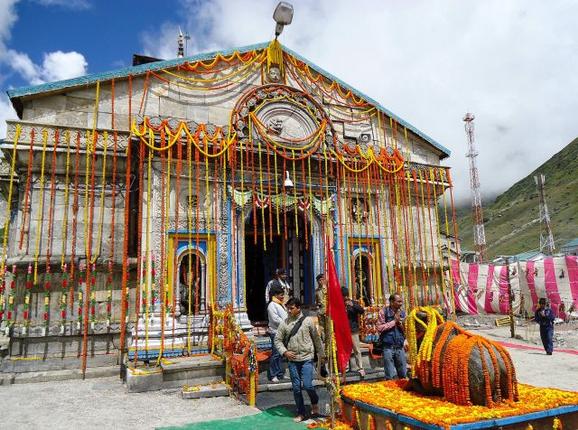
The most prominent festival held at Badrinath Temple is Mata Murti Ka Mela, which commemorates the descent of the river Ganges on mother earth. The mother of Badrinath, who is believed to have divided the river into twelve channels for the welfare of earthly beings, is worshiped during the festival. The place where the river flowed became the holy land of Badrinath. The Badri Kedar festival is celebrated during the month of June in both the temple and the Kedarnath temple. The festival lasts for eight days; artists from all over the country perform during the function. The major religious activities (or pujas) performed every morning are mahabhishek (ablution), abhishek, gitapath and bhagavat puja, while in the evening the pujas include geet govinda and aarti. Recital in vedic scripts like Ashtotram and Sahasranama is practiced during all the rituals. After aarti, the decorations are removed from the image of Badrinath and sandalwood paste is applied to it. The paste from the image is given to the devotees the next day as prasad during the nirmalaya darshan. All the rituals are performed in front of the devotees, unlike those in some Hindu temples, where some practices are hidden from them.Sugar balls and dry leaves are the common prasad provided to the devotees. The temple is closed for winter on the auspicious day of Vijayadasami during October–November-On the day of closure, Akhanda Jyothi, a lamp is lit filled with ghee to last for six months.Special pujas are performed on the day by the chief priest in the presence of pilgrims and officials of the temple.The image of Badrinath is notionally transferred during the period to the Narasimha temple at Jyotirmath, located 40 mi (64 km) away from the temple.The temple is reopened around April on Vasant Panchami, another auspicious day on the Hindu calendar. Pilgrims gather on the first day of opening of the temple after the winter to witness the Akhanda Jyothi. The temple is one of the holy places where the Hindus offer oblations to ancestors with the help of the priests. Devotees visit the temple to worship in front of the image of Badrinath in the sanctum and have a hold dip in Alaknanda River. The general belief is that a dip in the tank purifies the soul.
Arti/Pooja/seva
Shrimad Bhagwat Saptah Path – It is a special pooja performed at the temple on request. This pooja continues for seven days. This ritual is dedicated to Lord Krishna. There are 18000 mantras in the Shrimad Bhagwat Katha. A Yagna is performed on the last day of the Pooja. It is believed that by doing this Pooja, one gets rid of fear and misfortune in life. Vishnu Sahasranamam – It is a prayer consisting of the 1000 names of Lord Vishnu, each signifying the different attributes of Lord Vishnu. Ved Path – A recitation of verses from the four Vedas – Rig, Sam, Yajur, and Atharva. Geeta Path – The complete recital of the Shrimad Bhagawat Geeta is done in front of the deity. Akhand Jyoti – This temple is closed for pilgrims on VijayaDasami. On the last day, a special ghee mixture brought from the Mana village is bought here and lit. This lamp remains lit for six months.
Accommodation
Few government-run guest houses are available for pilgrims to stay. Some of them are GMVN Yatri Nivas Badrinath, GMVN Tourist Bungalow Devlok at Badrinath and GMVN Badrinath Rest House. Private accommodation is also available with price ranges suitable for all. Some of the recommended hotels are Hotel Narayan Palace, New Snow Crest Hotel and The Sarovar Portico, Badrinath.
Best time to visit
Badrinath has a cool and chilly climate all through the year but the best time to visit is from May to June and again from September to October. Winter (October to April) has chilly days with average minimum touching near 5°C. Minimum can touch sub zero levels and snowfall is very common. These months are not the perfect time for travelling. Summer (May to June) are very pleasant with moderately cold climate, with average around 18°C. Summers is ideal for all sight seeing and the holy Badrinath pilgrimage.
Monsoon (July to mid-September) are accompanied with regular rains and also temperature drops down to 15°C. The region is prone to occasional landslides and travelling can be difficult.
The holy city of Badrinath is open for public views from May to October but the temple remains closed during the monsoon months as landslides are common and can mar the journey of the pilgrims. The region experiences pleasant and cool summer while winters are very chilly and snowfall is a regular occurrence.
Significance
It is mentioned in the Vamana Purana that the sages Nara and Narayana (the dual form of Lord Vishnu’s fifth avatar) did penance here. The great sages of folklores like Kapila Muni, Gautam and Kashyap also did penance here. According to Hindu mythology, the head of Brahma fell from Shiva’s trident at the Brahma Kapal ghat located 300 mts from the Badrinath temple. Homages are offered to departed souls on this ghat. It is believed that Narada attained salvation atop the Narad Shila located at Badrinath. It is believed that the Vyas Cave situated near Badrinath is the place where Ved Vyas dictated the entire Mahabharata to Lord Ganesha. The Bheem Pul near Badrinath Temple was constructed by Bheem to make a path between two mountains so that Draupadi could cross it easily. The water of the hot spring Tapt Kund has medicinal values and therefore, a dip is a must to cure all ailments.
Accessibility
Airport
Jolly Grant airport Dehradun is the nearest airport 312Km from Badrinath temple. Cabs or buses can be hired directly from Dehradun to Badrinath or to go to Haridwar and Rishikesh and start the trip.
Railways
Rishikesh railway station is the nearest railhead 295Km from Badrinath temple. Cabs or buses can be hired to reach Badrinath temple from Rishikesh.
Road
The trip to Badrinath usually begins from Haridwar passing through Rishikesh-Devprayag-Rudraprayag-Karnaprayag-Nandprayag-Joshimath-Vishnuprayag and finally reaching Badrinath on bus or cab. Badrinath is 318Km from Haridwar.
Significance
Devotees visit this temple to seek fulfillment of the following:-
- For general well-being
- For spiritual fulfillment
Shlokas
Achutham Keyshavam Rama Narayanam Krishna Damodaram Vasudevam Harim Shridharam Madhavam Gopika Vallabham Janaki Nayakam Ramachandram Bhajey
Meaning -Oh Lord who cannot be perished, who also has names like Keshava, Rama, Damodara, Narayana, Sridhara, Madhava, Krishna, Ramachandra the beloved of Janaki, let me say your name regularly.
Vasudeva Sutham Devam Kamsa Chanoora Mardhanam Devaki Paramanandham Krishnam Vande Jagathgurum
Meaning -I bow to you O Krishna, the ultimate guru, Devaki and Vasudeva's son, and the destroyer of Kamsa and Chanur.
Adharam Madhuram Vadanam Madhuram Nayanam Madhuram Hasitam Madhuram Hridayam Madhuram Gamanam Madhuram Mathuraa Dhipate Rakhilam Madhuram
Meaning -Meaning - Sweet are Your lips, sweet is Your face, sweet are Your eyes, sweet is Your smile, sweet is Your heart, sweet is Your gait, O Lord of Mathura, everything about You is sweet.
Alokya Mathur Mukha Madarena Sthanyam Pibantham Saraseeruhaksham Sachinmayam Devam Anantha Roopam Balam Mukundam Manasa Smarami
Meaning -I think of this Balamukundan as the one who looks lovingly at his mother's face while taking milk from her, who has eyes similar to the red lotus, who is the embodiment of truth and intelligence and other forms.
Timings
Till the month of November, the temple is open for darshan
